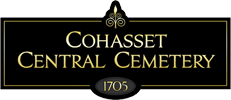The Origins of Conahasset
David Wadsworth
From David Wadsworth, "The Origins of Conahasset;" Cohasset Mariner, December 6, 1984. Reprinted by permission of the author.
Cohasset's origin was as the easternmost land in the town of Hingham. The parent settlement, originally called Bare Cove, had been well established by the year 1635 and soon began to expand into nearby vacant lands. By the end of the sixth decade of the seventeenth century, the salt marshes and meadows of the area had been granted by the town to numerous Hingham residents, but the upland areas east of Hingham, in the section called Conahasset, still remained undivided and were part of the town's common land. By this time Hingham's population was increasing, and so was the need to utilize vacant upland areas nearby. It was decided to divide up the Conahasset uplands, and a Hingham town meeting in 1669 determined the number of shares of common land each man should receive.
At town meeting held in Hingham on December 6, [16701, voters met to assign specific parcels of land to qualified residents. At that time, most of the Conahasset uplands passed from common land into private ownership by grants made by the town. The division of land at Conahasset followed the English method, having long but narrow strips of a given length. The width of each lot depended upon the number of shares to which the new owner was entitled. In this case the length of most new properties was one mile, except where natural boundaries interfered.
As anyone familiar with Cohasset's topography will attest, the town's land areas are anything but consistent in quality. Here, glacial gravel and clay are interspersed with granite ledges, and the rich topsoil so vital for agriculture is scarcely to be found. Hingham land division planners took the varied topography into account and attempted to provide some usable land to each owner along with the unusable. To achieve fairness, they first divided all of the Conahasset area into four large sections called the First, Second, and Third Divisions and the Second Part of the Third Division. Every new landholder received shares in each of the four divisions. In this way it was hoped that the best and worst of Conahasset's varied lands would be shared equally . . .
Soon after the 1670 land division, Hingham settlers began to establish the first farms and homesteads in Conahasset. Of the earliest dwelling places, none exist today. One of the oldest, owned by Israel Nichols, near Straits Pond, survived into the twentieth century and is remembered by long time residents. Joshua Bates's homestead on South Main Street appears to be the oldest extant, dating from 1695 and built on the fortieth lot of the First Land Division. Of those whose homes were the first in Conahasset, most were of the second generation of Hingham settlers. Names such as Bates, Lincoln, Souther, Tower, James, Nichols, Pratt, and Beal were among the earliest, and there were numerous others.
For many of the new landholders, the long, narrow lots laid out by surveyor Lieutenant Joshua Fisher were awkward to manage. The process of breaking up the original parcels and combining them into more workable properties began quite soon. Today, relatively few Cohasset properties are bounded by the original 1670 lot lines, though in some places the original boundaries still can be identified.
Not long after the first homes, the earliest industries arrived. Mordecai Lincoln harnessed Conahasset's Bound Brook to run a mill and ironworks in Beechwood, and Hingham's Cushing family operated a mill at the west end of Straits Pond, near Cohasset's West Corner. Shipbuilding started at Cohasset Harbor (called Ship Cove) by the year 1700. Subsequent generations of Cohasseters were to turn to the town's eastern frontier, the Atlantic Ocean, for their livelihood. The first years of the eighteenth century saw Hingham's easternmost village at Conahasset start to form itself into a community which within two more decades would itself challenge the parent town's authority and seek its own identity as a separate parish and government.

